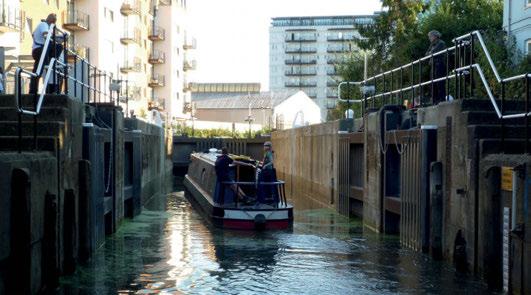
10 minute read
An Olympian Effort
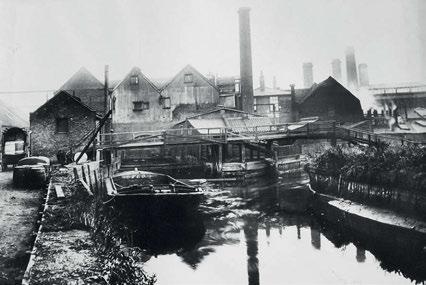
Tokyo 2020 may not be happening, but London’s Games’ legacy o ers boaters a sporting chance to cruise in the wake of athletics’ greatest...
As we head into an uncertain few months, there can be few be er tonics than looking back on happier times, not least the golden summer of 2012 when, for a few weeks in July, the world’s best sports stars smashed records and set audience pulses racing – and inadvertently brought about a brand-new cruising ground.
Opened to boating tra c in 2016, some four years a er the Games was wound up, the Queen Elizabeth Olympic Park Waterways nevertheless owe a debt to the massive regeneration project focused on east London in the run-up to the event. They comprise a previously hidden and derelict network of waterways known as the Bow Back Rivers – a 10-mile system feeding into the River Lee Navigation and the Thames and including Ci Mill River, Old River Lea, Bow Back River, Presco Channel, Bow Creek, Channelsea River and Waterworks River.
Potted history
The recorded history of the rivers dates back to Al ed the Great and the invasion of the Danes, when the River Lea was the border between England and Danelaw. During the Industrial Revolution the waterways played a major role in providing water to local industry, particularly in powering mills at Three Mills and Ci Mills. In the early 1930s major investment was injected into the Bow Backs to improve their abili to accommodate both fl oodwaters and navigation. Waterworks River was signifi cantly modifi ed and two new locks constructed at Ci Mills and Carpenters Road.
The rivers had largely fallen into disuse by the mid-20th century, with the decline in both canal carrying and waterside industries. The 1968 Transport Act classifi ed the Bow Backs as ‘Remainder Waterways’, e ectively deeming them no longer viable for leisure or commercial use.
By the 1990s the waterway network threaded its way through a landscape of redundant industry and degraded sites with minimal visitor activi . The rivers were heavily silted and largely unnavigable while their structures, although intact, were derelict and unusable.
Regeneration
In spite of this, the potential importance of the Bow Backs began to be recognised in the early 1990s when regeneration initiatives around Stratford started to emerge. In particular, the establishment of the Channel Tunnel Rail Link began the transformation in people’s a itudes towards this li le-known part of London. However, it was the decision to host the London 2012 Olympic and Paralympic Games in the Lower Lea Valley which created by far the biggest boost and, importantly, a timetable, for regenerating the area. In a short six-year period between 2005 and 2012 more than £50m of investment was made by various government agencies to transform the waterways of the Lower Lea Valley. The catalyst was the construction of a new lock and water control structure at Three Mills which has prevented tidal inundation into the Park, turning a 3.5-mile length of steepsided fl ood relief channel, with a tidal range between zero ordnance datum to over 4m, into a navigable watercourse integrated with the newly regenerated waterside, parklands, wetlands and wildlife areas.
Work included refurbishing an abandoned lock on Ci Mill River, rebuilding waterway walls and
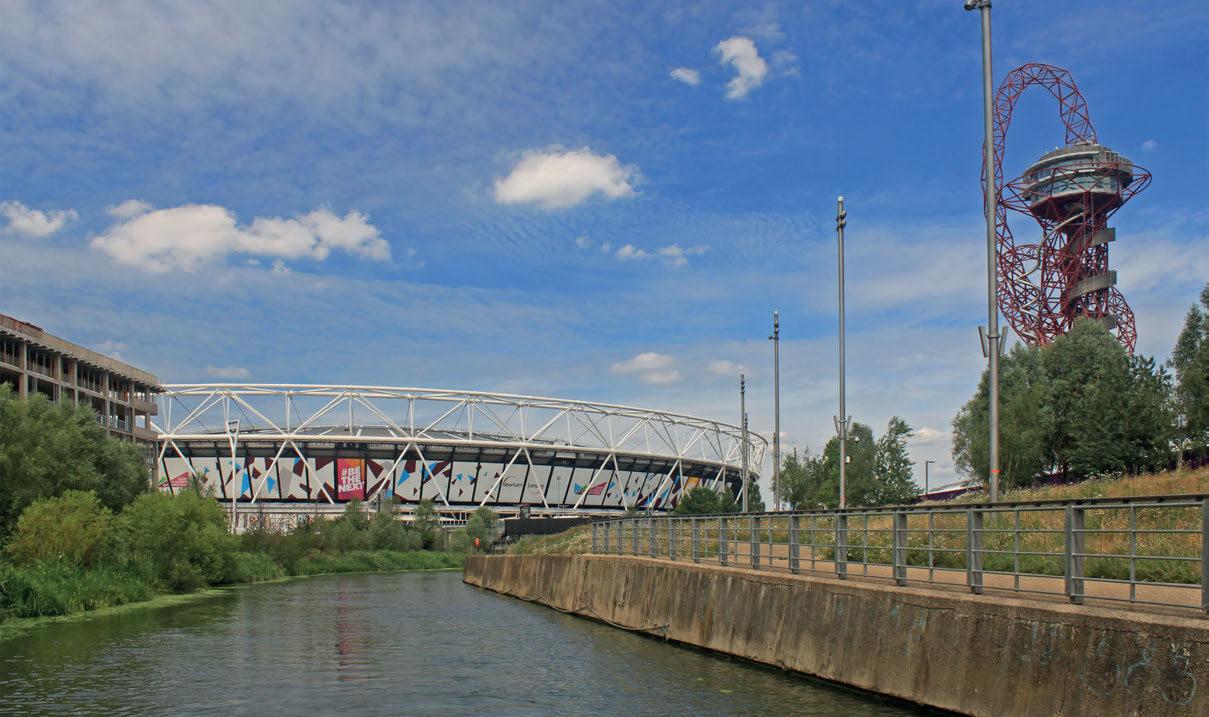
Marshgate Lock on Bow Back River, demolished during the 1930s fl ood control project and replaced by City Mill Lock.
London's new cruising ring
As part of the Queen Elizabeth Olympic Park Waterways, boaters can experience one of the network’s newest cruising rings. Called the Stadium Island Loop, due to the route orbiting the 2012 Olympic stadium that now serves as West Ham FC’s home ground, it is reached from the Lee Navigation, below Old Ford Locks, and takes in parts of the Old River Lee, City Mill River and Bow Back River.
Officially opened in 2016, boaters can cruise the loop without prior booking – the only exception to this being during major stadium events. Note that no stopping or mooring is allowed at the Stadium Island, with £150 fines for those who disobey and the potential for your boat to be “moved on” by CRT’s contractors District Enforcement Ltd.
As well as this ‘turn-up-and-go’ circuit, two adjoining waterways, the Waterworks River and Three Mills Wall River, are also available to cruise by booking passage through Carpenters Road, City Mill or Three Mills Lock in advance. You can 0 do this by logging into your CRT boating account and finding the ‘book your passage’ option. You’ll need to book at least seven days before your travel and passage is available from 9.30am to 4.30pm Monday to Friday, except when the locks are closed for maintenance, events or unsafe weather conditions. Check CRT’s stoppages section on its website for any planned or emergency closures.
towpaths, dredging deeper channels for commercial and leisure traffic, creating new wildlife habitats for birds and insects, installing infrastructure for trip-boats and establishing better, safer connections for walking and cycling.
In the south of the park, the waterways have a more urban feel – the legacy of the last major works programme in the 1930s and the construction of heavily engineered, man-made concrete channels. In the north of the park, the River Lea has been transformed to become a largely ecologically focussed, riverine environment with natural soft banks, wetlands and meandering footpaths through a rich valley landscape. The canals and rivers running through and adjacent to the park are now possibly the best connected waterways anywhere in the UK.
Olympics
Millions of people visited the park during the period of the London 2012 Olympic and Paralympic Games, which provided a valuable insight into how people used and enjoyed the area and its waterways. The water clearly had a magnetising effect, not just on visitors but also on those watching at home on television. Who can forget the moment David Beckham appeared aboard a speed boat on Waterworks River to hand over the Olympic Torch as part of the Opening Ceremony?!
After decades of inactivity and decay, the Bow Back Rivers revelled in this new lease of life, briefly opening their doors to stage the biggest sporting event in the world. For a few years after, however, boaters were left in frustrated limbo as the
6 Tottenham
4 8
A12
9
5 River Lee N avi g ati on Hackney Wick Bottom Lock
7 Ri ver L ea
Regent’s Canal Hertford Union Canal
2
1
map not to scale: covers approx. 1¾ mile / 2.8km Stratford International
Stratford
Old Ford Lock
3 City M ill R i verOld River Lea
St Thomas Creek
Bow Road Bow Church
Wa ter wor k s Ri v e r 11 Pudding Mill Lane
A11
Bromley-by-Bow
Limehouse Cut High StreetCity Mill T h ree Mills W all River Lock
Prescot t Channe l towpath railway London Underground 1 London Overground Docklands Light Railway Elsan and refuse point pump out water point calor gas 1 ArcelorMittal Orbit 2 London Stadium 21 3 Fish Island Labs 4 Carpenters Road Lock 5 Queen’s Yard 6 Here East Stratford High St 7 North Park Paddle Hub 13 8 Lee Valley Hockey and Tennis Centre 9 Lee Valley VeloPark 10 Copper Box Arena 11 Boat tours and pedalo hire Abbey Road 12 London Aquatics Centre 13 The House Mill Navigation West Ham bookable access only
Three Mills Lock no stopping/no mooring Bow low bridges - max air draft 2.0m Locks Bow Creek/ end of Canal & River Trust Navigation River Thames - no motorised craft
waterways closed once more for legacy transformation works to take place. The work hasn’t satisfied everyone, not least freight enthusiasts. But what were once the least glamorous waterways in Britain are now open for business, boasting a thoroughly modern makeover and still basking in the glory of having hosted one of our nation’s finest hours on their banks.
Building Carpenters Road Lock in the 1930s in the middle of the Old River Lea.

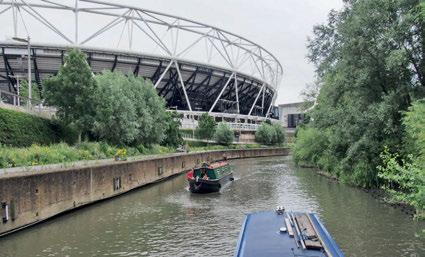
Construction dwarfs boats on Waterworks River near City Mill Lock.
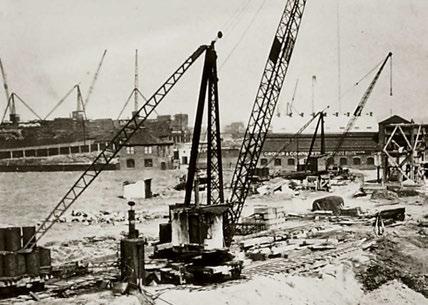
The Old River Lea now weaves past one of the world’s most iconic sporting venues.
Don't miss...
Roger Wilkinson, guide for IWA’s popular Towpath Walks initiative in London, picks out some overlooked non-sporting sights on the Olympic Waterways
1) All clear ahead!
Perhaps one of the most striking things on this route is actually what you won’t see! As well as the lack of moored boats, which are ubiquitous elsewhere in the capital, you might also notice the channel is clear of floating pennywort too. One of the Olympic Development Authority’s achievements before the Games was to dredge the Bow Back Rivers and remove this very troublesome invasive weed. Although it has reappeared on the Lee Navigation, there is very little on the Bow Back Rivers.
2) The Great British Garden (on the north bank, opposite the Stadium)
Behind the line of trees along the bank of the Old River Lea is a hidden gem. In 2012, the Royal Horticultural Society ran a competition for amateur gardeners to design a bit of the Olympic Park. The planting in the Great British Garden includes three zones with the themes of Gold, Silver and Bronze. Don’t miss the human sundial in the silver area; you can tell the time on a sunny day by standing in the middle of it.
Green-fingered readers may also be interested in the wildflower meadows planted in a number of places around the Queen Elizabeth Olympic Park. Some can be seen on the slopes beside the Bow Back Rivers near Carpenters Road Lock.
3) Carpenters Road Lock
Originally built in the early 1930s as part of a major public works scheme in the Bow Back Rivers, Carpenters Road Lock is the only one in the country with double radial gates. It was designed to be operable whether the water in the Waterworks River (then tidal, as well as a flood relief channel) was higher or lower than on the Lee Navigation. The weight of the radial gates was balanced by counterweights inside the side towers. This lock was manually operated (with a winding handle). Although commercial traffic through it probably ceased in the early 1950s, it continued to be useable until the end of the 1970s.
CRT succeeded in rebuilding it (now as an electrically powered lock) as closely as possible to the original design, and the counterweights can be seen moving when the gates open and close. It was officially reopened in August 2017.
The towpath bridge near Carpenters Road Lock is also worth attention. Painted light blue and with raised cobbles in the paved surface to provide better grip for horses’ hooves, it was built as part of the 1930s public works scheme.
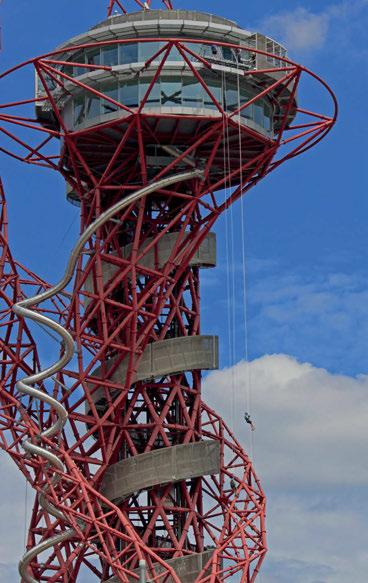
4) The Orbit Tower
The Orbit sculpture, Britain’s largest piece of public art, is now home to the world’s longest covered slide. Designed by German artist Carsten Höller, it is 178m long, and takes about 35 seconds to descend. It has proved to be very popular, and is sometimes booked up some time in advance.
Take note also of the construction works south of the Orbit sculpture, which are for UCL East. This will become a campus for UCL, with 4,000 students. There will be two student accommodation tower blocks (the first of which is due to be completed by autumn 2021) and a large research facility. It will be part of the East Bank – three locations in the Olympic Park which will form a culture and education district.
5) City Mill Lock
City Mill Lock was also built as part of the 1930s public works package, becoming unuseable and derelict many years ago. British Waterways succeeded in obtaining the funds and restoring it, and it reopened in July 2010. It was built with gates facing both ways to cope with the tide.
This feature is still useful in the event of flood conditions on the Waterworks River; you’ll notice that the ‘tidemark’ on the gates is noticeably above the level of the water on the Bow Back Rivers.
The lock-keeper’s house (built in early 1930s) still exists. Developers constructed new buildings very close to either end, but the dwelling (refurbished as part of the Olympics regeneration scheme) remains.

The rebuilding of Carpenters Road Lock was an enormous task.
Consider abseiling the Orbit if the slide is too tame for you!
